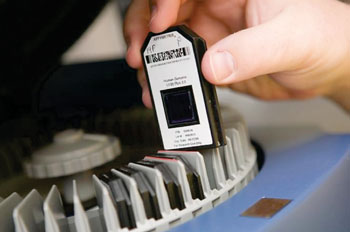Microarray Chip Rapidly Detects Dengue Fever
By LabMedica International staff writers
Posted on 22 Jul 2014
A chip has been developed that allows for the detection of the ribonucleic acid (RNA) strand of the virus that causes dengue fever, now endemic in 110 countries. Posted on 22 Jul 2014
The chip allows analysis of the complementary strand of DNA (cDNA) obtained from the dengue fever virus being carried by the infected patient and the cDNA is covalently linked to a slide or substrate that can be a glass or paper.

Image: A cDNA microarray on a chip for rapid detection of dengue fever (Photo courtesy of Investigación y Desarrollo).
Scientists at the Center for Research and Advanced Studies (Cinvestav; Mexico City, Mexico) used probes marked with fluorescent elements, called fluorochromes that can distinguish in the chip different colors according to the serotype of dengue fever the patient is carrying. Additionally, the cDNA microarray can display more than one color if the patient carries two serotypes.
The scientists said that knowing the precise serotype of dengue fever virus the patient is carrying, the progression of the disease would stop and an optimal follow up of the treatment would be held. There are five strains of the virus, called serotypes, of which the first four are referred to as DENV-1, DENV-2, DENV-3 and DENV-4 and the distinctions between the serotypes is based on their antigenicity. If a painkiller or an antihistamine are prescribed to the patient infected by the dengue virus, such drugs could cause a thinning of the blood vessels walls, thus triggering hemorrhagic fever.
Maria de Lourdes Muñoz Moreno, PhD, a senior scientist, at the Department of Genetics and Molecular Biology at Cinvestav, said, “When it comes to a second infection with another serotype, the antibodies that protect the body from dengue fever in the first infection, could now adhere to the virus of a new serotype, causing the cells to be more easily infected.” The group at Cinvestav is working to achieve a microarray that differentiates dengue fever from Chikungunya, a viral disease recently reported in Latin America that is transmitted in a dengue-like manner, causing an acute febrile phase lasting two to five days.
Related Links:
Center for Research and Advanced Studies













